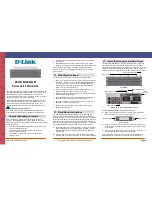
21.
Multicast VLAN Registration (MVR)
MN700004 Rev 01
257
mvr
The
mvr
command, in Global Configuration mode, enables MVR. The
no
form of this
command disables MVR.
By default, MVR is disabled.
When you disable MVR, the entire MVR configuration is erased.
Command Syntax
device-name
(config)#
mvr
device-name
(config)#
no mvr
Example
See the examples below.
mvr mode
The
mvr mode
command, in Global Configuration mode, specifies the mode of operation,
either
static
or
dynamic
.
The default MVR mode is
dynamic
.
Command Syntax
device-name
(config)#
mvr
mode
dynamic
|
static
[
group
A.B.C.D
[<
count
>]]
[
querytime
<value>
][
vlan
<
vlan-id
>]
device-name
(config)#
mvr
mode
static
[
vlan
<
vlan-id
>]
Argument Description
dynamic
The switch forces the multicast server to send all configured multicast-group data to
the source port, without waiting for join requests from receiver ports. When a user on
a receiver port sends a join to a multicast group, it immediately starts receiving the
multicast data.
The response to joins and channel zapping is quick, at the expense of loading the
switch with traffic from all the configured multicast groups all the time.
If no multicast group is defined the default will be 224.0.0.1.
Under normal conditions, dynamic mode is preferable.
static
Multicast data is sent only after a request has been sent from a receiver port to join
that multicast group. The response in this mode is slower than the response in
dynamic mode, but the switch is not loaded with traffic from unused multicast groups.
vlan
vlan-id
ID of the VLAN on which MVR multicast data is expected in range <1-4094>. The
default VLAN ID is 1.
A.B.C.D
The IP multicast address of the MVR group.
count
(Optional) Configures multiple contiguous MVR group addresses. The default is 1. The
allowed range is <1-256>.
value
The response time in seconds. The default is 10 seconds. The allowed range is <1-25>
seconds.
Example
See the examples below.
















































